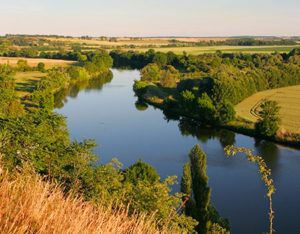The Ohio River flows from Pittsburgh, Pennsylvania, to Cairo, Illinois, and empties into the Mississippi River. Thousands of wastewater utilities, 46 power plants, and more than 230,000 farmers reside in an eight-state area within the Ohio River Basin.
All of these sources can emit pollution that winds up in the Gulf of Mexico, contributing to the hypoxic zone (or “dead zone”) where the water is devoid of oxygen and unable to support life.
The costs to reduce emissions from the different sources vary. Water quality trading provides an option for businesses with high treatment costs to pay those with lower treatment costs to keep nutrients out of the water.
Trading Project and AFT
American Farmland Trust is part of an innovative, award-winning project reducing pollution and improving the health of the Ohio River. Since 2009, the Electric Power Research Institute and AFT, along with a strong collaboration of power companies, farmers, state and federal agencies, and environmental interests, have been developing an interstate water quality trading program in Ohio, Indiana, and Kentucky.
The program connects buyers of nutrient credits (power plants, wastewater utilities, and corporations) with sellers (farmers) to benefit the environment.
How Water Quality Trading Works
Farmers implement conservation practices that reduce soil erosion and runoff, generating credit.
Power plants or other buyers purchase these credits, reimbursing farmers for their costs while improving the overall health of the river.
The result? Less runoff in the river and into the Gulf of Mexico. Farmers can try conservation practices without cost concerns. Since practices are implemented in multiple locations, the resulting benefits are felt throughout the watershed and not just at the point where the buyer is located. And the program is designed so that some of the credits farmers generate are not sold but are retired for the good of the basin. Therefore, we expect real improvements in water quality over time.


